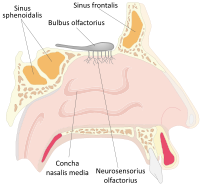Nasal Pain – Causes of Pain On or Inside the Nose
Pain on or in the nose can be quite distressing. We often tend to get more concerned about pain anywhere on the head, and particularly with parts of the face, than we do with pain elsewhere on the body. But many of the cause of facial pain are similar to pain that affects other parts of the body. Nasal pain is no different. It can be due to an acute injury like a blow to the face, and specifically when the nose is struck. It may be as common as a cold or the flu. But it can also be due to some fairly rare and serious condition like cancers within the nose or lower parts of the brain.
First it is important to realize that the nose is the outer visible portion which protrudes from the face. Through the nostrils it leads into the nasal cavity. This is divided by the nasal septum which we sometimes refer to as the bridge of the nose. The paranasal sinuses are connected to the nasal cavity through tiny holes. These sinuses are hollow pockets in the skull gone.

The nasal cavity extends towards the back where it joins the throat (pharynx) is known as the nasopharynx. It is continuous with the part of the throat that joins the mouth which is the oropharynx. Given that the nasal cavity is separated by thin bone from the cranial (brain) cavity above it, and oral (mouth) cavity below it, problems in these cavities can also cause nasal pain. Similarly throat problems may also be perceived as nasal pain.
Nose Injury
We all know that a broken nose can be painful. The term ‘broken nose’ refers a fracture of one of the nasal bones. It is very painful and often there is swelling with/without bleeding of the nose. Nasal fractures often occur with trauma to the face, as may occur during sporting injuries, severe falls or as a result of being assaulted. Sometimes blood can pool in the septum after an injury. This is known as a nasal septal hematoma and it needs to be drained as soon as possible. Even without a fracture or hematoma, there may be nose sensitivity after injury.

Trauma in sports, accidents and assaults is not the only way that the nose may be injured. Common external injuries can vary from wiping the nose too often or aggressively when you have a runny nose or with crying to an injury from a nose piercing or inserting an object into the nose. Injuries are usually acute, meaning that it arises suddenly, causes intense pain and often heals without any permanent problems. However, if the pain is severe it is always advisable to seek medical attention.
Foreign Body in the Nose
A foreign body in the nose is more often seen with children. Common objects inserted into the nose includes marbles, pencil erasers, small beads and other tiny objects that fit in the nose. Swelling of the delicate inner lining of the nose causes the object to become firmly stuck in the nose. The pain may initially be inside the nose but as time passes, the outside of the nose also becomes painful and tender to touch. The object is often inserted during the course of play.
Sometimes objects may be lodged in the nose for days without any symptoms. It can even enter the paranasal sinuses. Apart from pain there may be nasal congestion, a runny nose, difficulty smelling, a nasal tone to the voice and sometimes bleeding from the nose. A foreign body in the nose should only be removed by a doctor with specialized equipment. Trying to do so at home can push the object deeper and inflamed the tissue surrounding it which holds the object tighter.
Nasal Infection
Nasal infections are common. It can be as simple as a common cold but often viral infections tend to cause burning in the nose and soreness rather than pain. A bacterial infection of the nose and sinuses, particularly of the ethmoid sinuses, is more likely to cause nasal pain especially when it is severe. However, fungi can also cause an infection. A weakened immune system may allow for a certain species of fungi to infect the nose and sinuses, thereby leading to nasal pain. This is known as mucormycosis.
Sometimes an infection can occur at the entrance of the nostrils (vestibule). This is a common infection known as nasal vestibulitis. It may occur after a cold, with wiping the nose excessively or by vigorous nose picking. The root of the nose hairs in the vestibule may become infected an a boil (abscess) can form, which is known as nasal furunculosis. A nasal septum abscess is another infectious nose problem that leads to nasal pain.
Nasal Inflammation
Non-infectious conditions where there is inflammation of the nose cause nasal pain as well. Most types of non-infectious nasal inflammation (rhinitis), like allergic rhinitis (hayfever), do not cause pain in the nose but there may be other sensations like an itchy nose. Apart from injury to the nose as described above, mechanical and chemical irritation can both cause nose pain. It may include nose picking, sniffing cocaine, excessive nasal drying, very hard dried nasal mucus, inhaling irritant gases and using certain types of nasal sprays. Usually the pain is short lived in these cases.

Two relatively uncommon but important inflammatory conditions that may cause nasal pain are Wegener’s granulomatosis and lethal midline granuloma. Both conditions lead to the formation of inflammatory tissue known as granulomas. In Wegener’s granulomatosis the blood vessels of the nose become inflamed and granulomas may form. This condition can occur anywhere in the body. Lethal midline granuloma is not a life-threatening condition despite its name. It is a rare condition where there is destruction of the nose and respiratory passages.
Cancer and Growths
One of the most common growths within the nose is a nasal polyp. It is not cancerous but can occur malignancies in the nasal cavity. Most nasal polyps do not cause pain but as the growth increases in size, pain may arise. The exact cause for nasal polyp development is unknown. It is believed to arise from chronic irritation of the lining of the nasal passages. There are other types of growths that may be present which is sometimes broadly referred to as nasal sores.
Cancer of the nose on its own is not very common. Nasal carcinoma can sometimes arise as a result of metastasis (cancer spread) from another site, especially in the case of the orbit of the skull (orbit metastasis). Cancer can also occur in the paranasal sinuses and nasopharynx, both of which may cause nose pain. Changes in the sense of smell, a nasal tone of the voice and bleeding from the nose are other symptoms that may occur along with the nasal pain.





